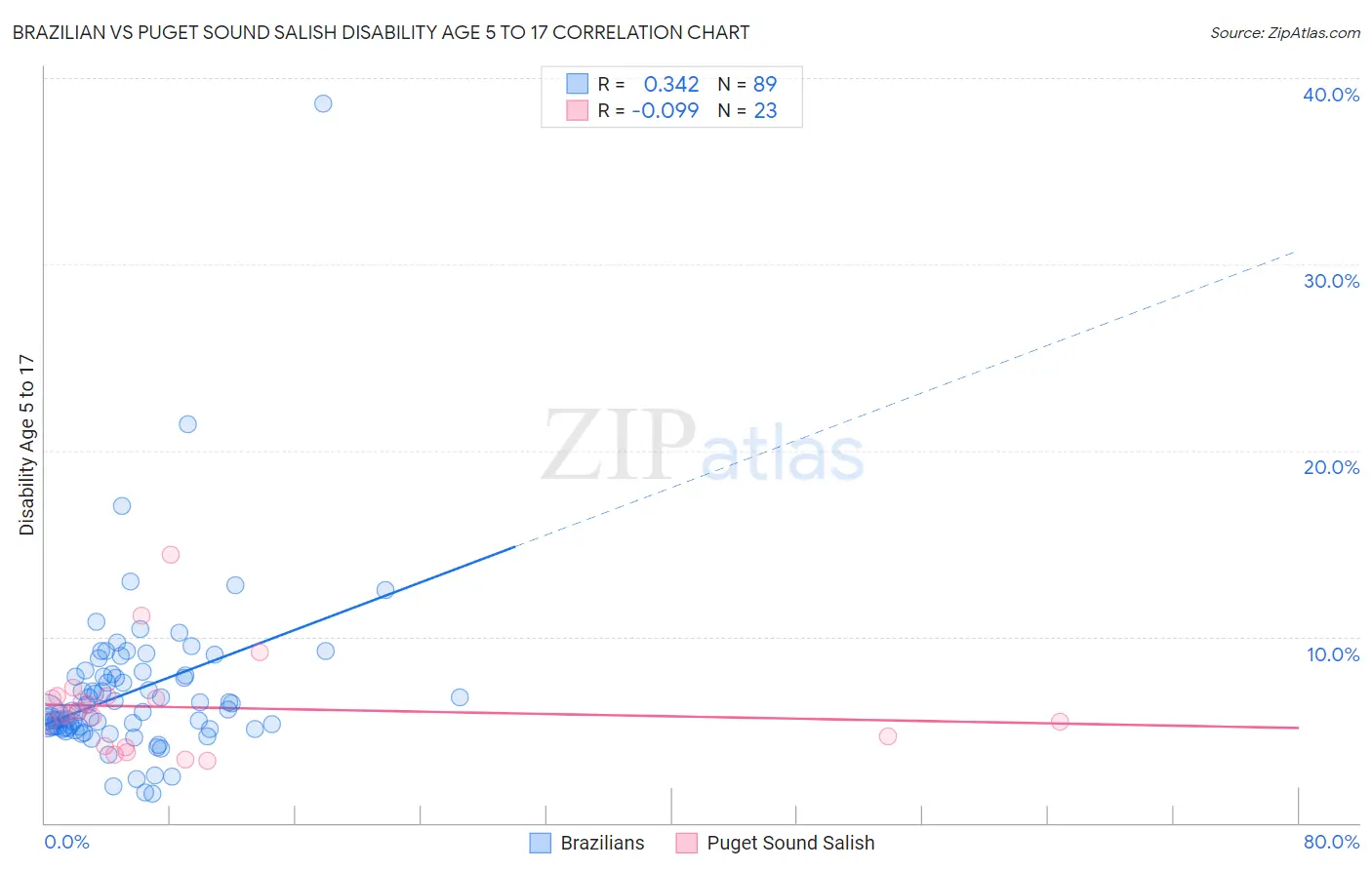Brazilian vs Puget Sound Salish Disability Age 5 to 17
COMPARE
Brazilian
Puget Sound Salish
Disability Age 5 to 17
Disability Age 5 to 17 Comparison
Brazilians
Puget Sound Salish
5.9%
DISABILITY AGE 5 TO 17
0.9/ 100
METRIC RATING
258th/ 347
METRIC RANK
6.1%
DISABILITY AGE 5 TO 17
0.1/ 100
METRIC RATING
277th/ 347
METRIC RANK
Brazilian vs Puget Sound Salish Disability Age 5 to 17 Correlation Chart
The statistical analysis conducted on geographies consisting of 321,958,150 people shows a mild positive correlation between the proportion of Brazilians and percentage of population with a disability between the ages 5 and 17 in the United States with a correlation coefficient (R) of 0.342 and weighted average of 5.9%. Similarly, the statistical analysis conducted on geographies consisting of 46,037,254 people shows a slight negative correlation between the proportion of Puget Sound Salish and percentage of population with a disability between the ages 5 and 17 in the United States with a correlation coefficient (R) of -0.099 and weighted average of 6.1%, a difference of 2.9%.

Disability Age 5 to 17 Correlation Summary
| Measurement | Brazilian | Puget Sound Salish |
| Minimum | 1.6% | 3.3% |
| Maximum | 38.7% | 14.4% |
| Range | 37.1% | 11.1% |
| Mean | 7.1% | 6.2% |
| Median | 6.0% | 5.8% |
| Interquartile 25% (IQ1) | 5.1% | 4.1% |
| Interquartile 75% (IQ3) | 8.0% | 6.8% |
| Interquartile Range (IQR) | 2.8% | 2.7% |
| Standard Deviation (Sample) | 4.5% | 2.6% |
| Standard Deviation (Population) | 4.5% | 2.5% |
Demographics Similar to Brazilians and Puget Sound Salish by Disability Age 5 to 17
In terms of disability age 5 to 17, the demographic groups most similar to Brazilians are Hispanic or Latino (5.9%, a difference of 0.040%), Slavic (5.9%, a difference of 0.060%), Somali (5.9%, a difference of 0.19%), Immigrants from Middle Africa (5.9%, a difference of 0.26%), and Immigrants from Western Africa (5.9%, a difference of 0.29%). Similarly, the demographic groups most similar to Puget Sound Salish are Japanese (6.1%, a difference of 0.72%), Dutch (6.0%, a difference of 0.82%), Cheyenne (6.0%, a difference of 0.93%), Alaska Native (6.0%, a difference of 1.1%), and Finnish (6.0%, a difference of 1.1%).
| Demographics | Rating | Rank | Disability Age 5 to 17 |
| Hispanics or Latinos | 1.0 /100 | #257 | Tragic 5.9% |
| Brazilians | 0.9 /100 | #258 | Tragic 5.9% |
| Slavs | 0.9 /100 | #259 | Tragic 5.9% |
| Somalis | 0.8 /100 | #260 | Tragic 5.9% |
| Immigrants | Middle Africa | 0.7 /100 | #261 | Tragic 5.9% |
| Immigrants | Western Africa | 0.7 /100 | #262 | Tragic 5.9% |
| Czechoslovakians | 0.7 /100 | #263 | Tragic 5.9% |
| Canadians | 0.6 /100 | #264 | Tragic 6.0% |
| Panamanians | 0.6 /100 | #265 | Tragic 6.0% |
| Slovenes | 0.6 /100 | #266 | Tragic 6.0% |
| Spanish | 0.5 /100 | #267 | Tragic 6.0% |
| Sioux | 0.4 /100 | #268 | Tragic 6.0% |
| Liberians | 0.4 /100 | #269 | Tragic 6.0% |
| Immigrants | Somalia | 0.4 /100 | #270 | Tragic 6.0% |
| Immigrants | Zaire | 0.2 /100 | #271 | Tragic 6.0% |
| Finns | 0.2 /100 | #272 | Tragic 6.0% |
| Alaska Natives | 0.2 /100 | #273 | Tragic 6.0% |
| Cheyenne | 0.2 /100 | #274 | Tragic 6.0% |
| Dutch | 0.2 /100 | #275 | Tragic 6.0% |
| Japanese | 0.1 /100 | #276 | Tragic 6.1% |
| Puget Sound Salish | 0.1 /100 | #277 | Tragic 6.1% |